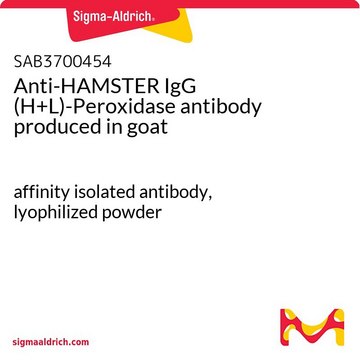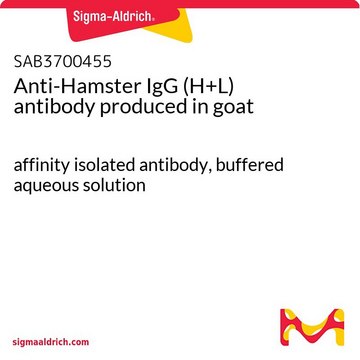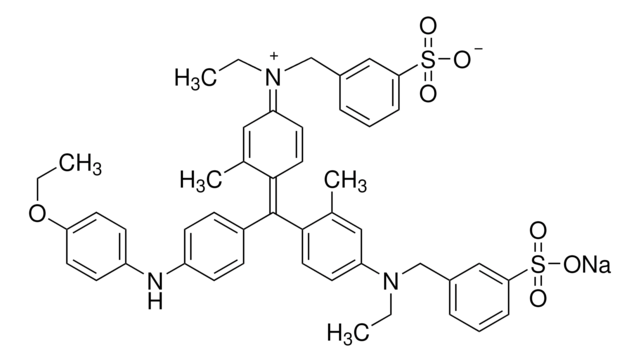H1643
Anti-Hamster IgG (whole molecule) antibody produced in rabbit
affinity isolated antibody, buffered aqueous solution
Faça loginpara ver os preços organizacionais e de contrato
About This Item
Produtos recomendados
fonte biológica
rabbit
conjugado
unconjugated
forma do anticorpo
affinity isolated antibody
tipo de produto de anticorpo
secondary antibodies
clone
polyclonal
Formulário
buffered aqueous solution
técnica(s)
indirect ELISA: 1:100,000
Condições de expedição
dry ice
temperatura de armazenamento
−20°C
modificação pós-traducional do alvo
unmodified
Descrição geral
IgG is present in large quantities in the human serum. IgG is composed of glycoproteins, out of which it is 82-96% proteins and 4-18% carbohydrates. It consists of four sub-classes i.e IgG1, IgG2, IgG3, and IgG4. IgG is composed of four polypeptide chains-two heavy chains (γ chains) and two light chains (κ or λ chains) which are linked by inter-chain disulfide bonds. The heavy chains consist of a N-terminal variable domain (VH) and three constant domains (CH1, CH2, CH3). A hinge region exists between the CH1 and CH2 region. The light chains have one N-terminal variable domain (VL) and one constant domain (CL). The heavy and the light chains are linked at VH and CH1 domain to form the Fab arm (Fragment antigen binding). The antigen binds to the V regions of the antibody.
Aplicação
Anti-Hamster IgG (whole molecule) antibody produced in rabbit is suitable for use in Immunoelectron Microscopy and FACS.
Ações bioquímicas/fisiológicas
IgG antibody subtype is the most abundant serum immunoglobulin of the immune system. It is secreted by B cells and is found in blood and extracellular fluids and provides protection from infections caused by bacteria, fungi and viruses. Maternal IgG is transferred to fetus through the placenta that is vital for immune defense of the neonate against infections.
IgG, a monoclonal antibody can be cleaved at the hinge region by nonspecific proteases like papain and pepsin. This can result in univalent Fab (Fragment antigen binding) fragments or bivalent F(ab′)2 fragments. These two enzymes have a broad substrate specificity resulting in heterogenous fragments.
forma física
Solution in 0.01 M phosphate buffered saline, pH 7.4, containing 15 mM sodium azide as preservative
Exoneração de responsabilidade
Unless otherwise stated in our catalog or other company documentation accompanying the product(s), our products are intended for research use only and are not to be used for any other purpose, which includes but is not limited to, unauthorized commercial uses, in vitro diagnostic uses, ex vivo or in vivo therapeutic uses or any type of consumption or application to humans or animals.
Não está encontrando o produto certo?
Experimente o nosso Ferramenta de seleção de produtos.
Código de classe de armazenamento
12 - Non Combustible Liquids
Classe de risco de água (WGK)
nwg
Ponto de fulgor (°F)
Not applicable
Ponto de fulgor (°C)
Not applicable
Escolha uma das versões mais recentes:
Já possui este produto?
Encontre a documentação dos produtos que você adquiriu recentemente na biblioteca de documentos.
C Reis e Sousa et al.
The Journal of experimental medicine, 178(2), 509-519 (1993-08-01)
Dendritic cells (DC) isolated from lymphoid tissues are generally thought to be nonphagocytic in culture. It has therefore been unclear how these cells could acquire particulate antigens such as microorganisms for initiation of primary immune responses. Lymphoid DC derive in
Vinay Kumar et al.
JACC. Basic to translational science, 7(10), 1038-1049 (2022-11-08)
CD4+ T cells turn pathological during heart failure (HF). We show that the expression of tumor necrosis factor (TNF)-α and tumor necrosis factor receptor (TNFR1) increases in HF-activated CD4+ T cells. However, the role of the TNF-α/TNFR1 axis in T-cell
Papain digestion of different mouse IgG subclasses as studied by electrospray mass spectrometry
Adamczyk M, et al.
Journal of Immunological Methods, 237(1-2), 95-104 (2000)
Gestur Vidarsson et al.
Frontiers in immunology, 5, 520-520 (2014-11-05)
Of the five immunoglobulin isotypes, immunoglobulin G (IgG) is most abundant in human serum. The four subclasses, IgG1, IgG2, IgG3, and IgG4, which are highly conserved, differ in their constant region, particularly in their hinges and upper CH2 domains. These
S Hashira et al.
Pediatrics international : official journal of the Japan Pediatric Society, 42(4), 337-342 (2000-09-15)
Maternal immunoglobulin G (IgG), transferred across the placenta to the fetus during intrauterine life, is an important component of the neonatal immunological defence mechanisms against infection. There is controversy with respect to differences in placental transfer of the different IgG
Nossa equipe de cientistas tem experiência em todas as áreas de pesquisa, incluindo Life Sciences, ciência de materiais, síntese química, cromatografia, química analítica e muitas outras.
Entre em contato com a assistência técnica







